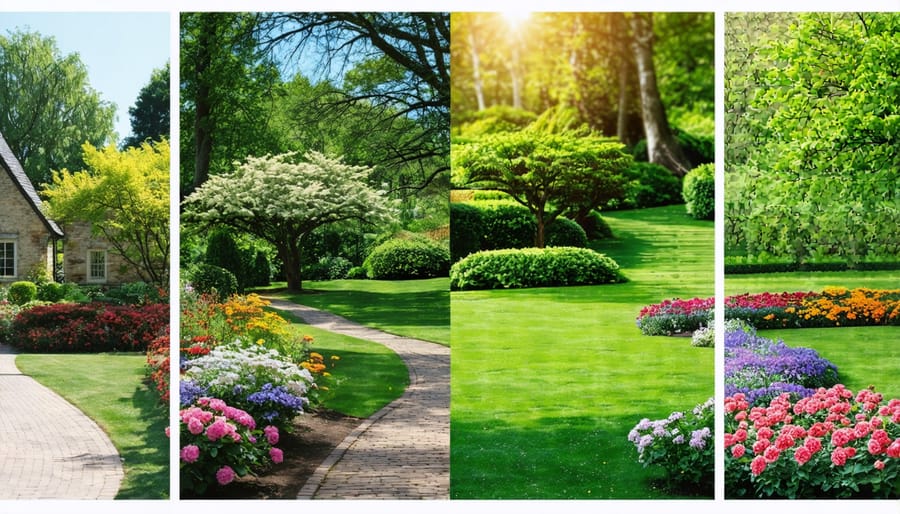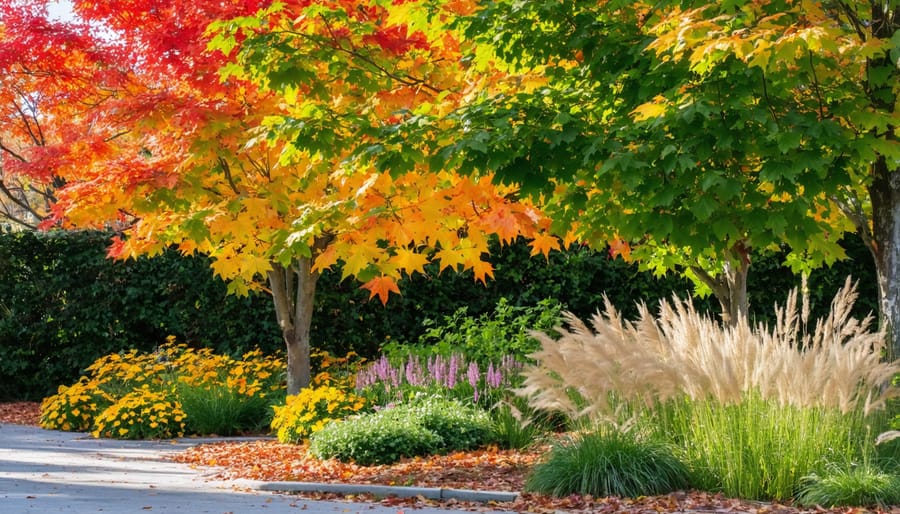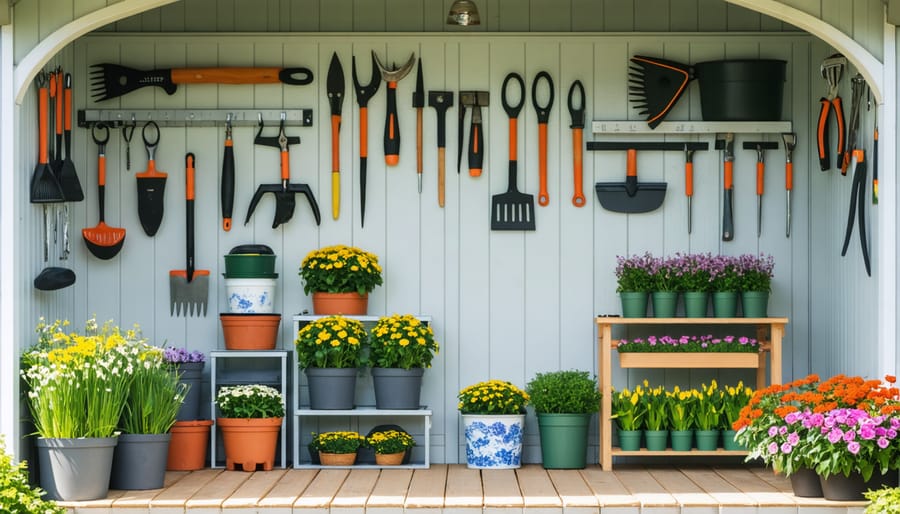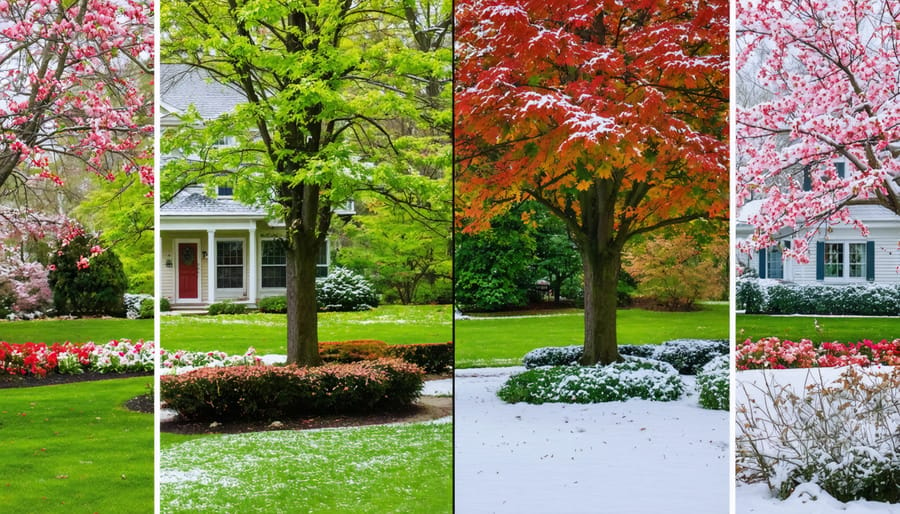Transform your outdoor space into a year-round sanctuary through strategic four-season landscaping. Smart plant selection, thoughtful hardscaping, and seasonal maintenance create a dynamic yard that captivates from January through December. By incorporating evergreen foundations, seasonal blooms, and weather-resistant features, your landscape remains vibrant even as temperatures fluctuate. Native plants anchor the design, while deciduous trees provide changing interest through colorful spring blossoms, summer shade, autumn foliage, and striking winter silhouettes. Strategic lighting, water features, and textural elements ensure your outdoor space remains engaging through snow, rain, and sunshine. This comprehensive approach to landscaping doesn’t just enhance curb appeal—it creates an evolving outdoor environment that responds beautifully to nature’s rhythms while requiring minimal maintenance during each distinct season.

Spring: Setting the Foundation
Essential Spring Clean-Up
As winter’s chill fades away, your landscape needs special attention to bounce back and prepare for the growing season ahead. Start by removing fallen branches, dead leaves, and winter debris that can smother emerging plants and create breeding grounds for pests. Pay particular attention to areas around perennials and shrubs where material tends to accumulate.
Next, assess your lawn for signs of snow mold or winter damage. Gently rake matted areas to promote air circulation and help grass recover faster. This is also the perfect time to edge your beds and repair any damage to hardscaping elements that may have occurred during freeze-thaw cycles.
Prune dead or damaged branches from trees and shrubs, but wait until after flowering for spring-blooming plants. Clean and sharpen your gardening tools, ensuring they’re ready for the busy season ahead. Check irrigation systems for damage and clean out clogged sprinkler heads.
Early spring is ideal for soil testing and amendment. Add compost to garden beds and apply a fresh layer of mulch, but wait until the soil has warmed up to prevent trapping cold temperatures around plant roots. Don’t forget to clean out your gutters and downspouts to ensure proper drainage during spring rains.
Finally, inspect outdoor storage areas and organize your gardening supplies. A well-organized start to the season sets the foundation for successful year-round landscaping maintenance.
Spring Planting Strategy
Spring sets the foundation for your year-round landscaping success. Start by assessing your soil quality as soon as the ground thaws, adding organic matter and adjusting pH levels if needed. Early spring is perfect for planning and implementing your garden layout, focusing on both quick-blooming varieties and long-term growth strategies.
Consider incorporating spring favorites like tulips, daffodils, and crocuses, which should be planted in fall for early spring blooms. Add depth to your landscape with flowering shrubs such as forsythia and lilac, which provide structure throughout the year. To extend your growing season, start seeds indoors 6-8 weeks before the last frost date.
Early maintenance is crucial for spring success. Remove winter debris, prune dead branches, and edge beds before new growth emerges. Apply a pre-emergent herbicide to control weeds before they take hold, and refresh mulch to retain moisture and suppress weed growth.
Create visual interest by layering plants of different heights and bloom times. Place taller spring-blooming plants like delphinium and foxglove toward the back of beds, with shorter varieties like pansies and primrose in the front. Include early-season perennials like hellebores and bleeding hearts for reliable yearly returns.
Remember to maintain proper spacing between plants to allow for mature growth and good air circulation, which helps prevent fungal diseases common in spring’s wet conditions.
Summer: Peak Beauty and Maintenance
Heat-Resistant Design Elements
Creating a heat-resistant landscape is essential for maintaining a beautiful yard throughout scorching summers. Start by selecting drought-resistant plants like lavender, sage, and Russian sage, which not only survive high temperatures but also add stunning color to your garden. Native plants are particularly well-suited to local climate conditions and typically require less water and maintenance.
Incorporate strategic shade features to protect both plants and outdoor living spaces. Consider installing pergolas or arbors covered with climbing vines, which provide natural cooling while adding visual interest. Large decorative umbrellas or sail shades can create instant relief from the sun in seating areas and protect delicate plants during peak heat hours.
Mulching is crucial for heat-resistant landscaping. Apply a 2-3 inch layer of organic mulch around plants to retain moisture, regulate soil temperature, and reduce water evaporation. Consider using rock gardens or gravel in high-heat areas, as these elements can create attractive focal points while minimizing water needs.
Water-wise irrigation systems, such as drip lines or soaker hoses, deliver moisture directly to plant roots, reducing waste and ensuring efficient water use during hot spells. Installing a rain sensor on your irrigation system prevents unnecessary watering during natural rainfall, saving both water and money while maintaining your landscape’s health throughout the warmest months.
Summer Maintenance Schedule
Summer brings peak growing season, requiring a well-structured maintenance routine to keep your landscape thriving. Start by establishing a consistent mowing schedule, typically every 5-7 days, adjusting the blade height to 3 inches to protect grass roots from summer heat. Early morning maintenance is ideal, allowing plants to recover before intense afternoon sun.
Implementing smart water management strategies becomes crucial during hot months. Set up automatic irrigation systems to water deeply but infrequently, encouraging strong root growth. Water early morning or late evening to minimize evaporation, and consider installing moisture sensors to optimize water usage.
Regular deadheading of flowering plants encourages continuous blooming throughout the season. Maintain a 2-3 inch layer of mulch around plants and trees to retain moisture and suppress weed growth. Weekly weeding prevents unwanted plants from competing for water and nutrients.
Monitor for signs of pest infestation or disease, especially during humid periods. Treat issues promptly with appropriate organic solutions when possible. Trim shrubs and hedges to maintain shape and encourage healthy growth, but avoid heavy pruning during intense heat.
Remember to clean and sharpen your tools regularly, storing them properly in your shed to prevent rust and ensure they’re ready for next week’s maintenance routine.
Fall: Preparing for Change
Fall Color Planning
Fall brings a spectacular show of colors to your landscape, and with proper planning, you can create a stunning autumn display. Start by incorporating trees and shrubs known for their vibrant fall foliage, such as maple, dogwood, and burning bush. Layer your landscape with different heights and textures, placing taller trees in the background and shorter shrubs in the foreground.
Consider adding late-blooming perennials like asters, chrysanthemums, and sedum to maintain color at ground level. Ornamental grasses, which turn golden in autumn, add movement and visual interest while requiring minimal maintenance. Japanese maples and sweetgum trees offer reliable color changes and can serve as focal points in your yard.
Managing fall cleanup doesn’t have to be overwhelming. Create a schedule for leaf removal, tackling the task in stages rather than waiting until all leaves have fallen. Use mulching mowers to break down leaves into natural fertilizer for your lawn. Consider designating a composting area for excess leaves, which will provide valuable organic matter for next year’s garden.
For areas where leaves tend to collect, install temporary barriers or fencing to prevent them from overwhelming garden beds or clogging drainage systems. Keep pathways clear by regular sweeping or blowing, and protect sensitive plants from heavy leaf coverage that could lead to fungal growth or root damage.

Winter Prep Checklist
Before winter arrives, it’s crucial to prepare your landscape for the harsh conditions ahead. Start by thoroughly cleaning your yard of fallen leaves and debris, which can suffocate grass and create favorable conditions for winter mold. Trim back perennials and remove dead annual plants, but leave ornamental grasses for winter interest and to create winter-resistant landscape features.
Protect young trees and shrubs by wrapping them in burlap or using tree guards to prevent winter burn and animal damage. Apply a thick layer of mulch around plants, keeping it away from direct contact with stems and trunks to prevent rot. This insulating layer helps regulate soil temperature and moisture levels throughout the cold season.
Don’t forget to drain and store your irrigation system properly. Disconnect and drain garden hoses, and store them in your shed to prevent freeze damage. Clean and sharpen your garden tools before storing them for winter, applying a light coat of oil to prevent rust.
For hardscape elements, inspect and repair any cracks in walkways or retaining walls, as freeze-thaw cycles can worsen existing damage. Remove or secure outdoor furniture and decorations that might not withstand winter storms. Finally, mark the edges of your driveway and walkways with reflective markers to guide snow removal efforts and protect your landscape features during winter maintenance.
Winter: Creating Visual Interest
Winter-Interest Features
When winter strips away autumn’s vibrant colors, thoughtfully planned winter-interest features keep your landscape engaging and beautiful. Evergreen trees and shrubs form the backbone of winter landscaping, providing reliable structure and color throughout the coldest months. Consider incorporating a mix of different evergreens, such as blue spruce, boxwood, and holly, to create varying heights, textures, and shades of green.
Ornamental grasses left uncut through winter add movement and sound to your garden while providing shelter for wildlife. Varieties like fountain grass and maiden grass develop attractive seed heads that catch frost and snow, creating stunning natural sculptures. Strategic placement of decorative elements like colorful garden stakes, frost-resistant containers, or artistic trellises adds visual interest when plants are dormant.
Structural features play a crucial role in winter landscapes. Arbors, pergolas, and decorative fencing become more prominent and create appealing silhouettes against winter skies. Consider installing landscape lighting to highlight these architectural elements and create warm, inviting spaces during long winter evenings.
Plants with interesting bark or branches, such as red-twig dogwood or paper birch, provide striking visual contrast against snow. Berry-producing shrubs like winterberry not only add splashes of color but also attract winter birds, bringing life and movement to your garden during the coldest months.
Remember to position these winter features where they’ll be visible from your home’s windows, creating beautiful views you can enjoy from indoors during harsh weather.
Winter Protection Methods
When winter approaches, protecting your landscape investments becomes crucial for maintaining their beauty and health throughout the cold season. Start by wrapping vulnerable shrubs and young trees with burlap or specialized plant covers to shield them from harsh winds and heavy snow. For delicate perennials, apply a thick layer of mulch around their base after the ground freezes to prevent frost heaving.
Don’t forget your hardscape elements – drain and cover water features to prevent freeze damage, and treat natural stone surfaces with appropriate sealants to guard against winter’s freeze-thaw cycles. Remove or safely store outdoor furniture, and consider using pot feet under any containers that must remain outdoors to prevent cracking.
For evergreens, especially those prone to winter burn, apply an anti-desiccant spray in late fall and again mid-winter during a period of above-freezing temperatures. Create windbreaks for particularly exposed areas using temporary barriers or strategic placement of potted evergreens.
Pay special attention to newly planted specimens, as they’re most vulnerable during their first winter. Consider using temporary structures like cold frames or row covers for sensitive plants, and keep an eye on snow accumulation on branches – gentle removal can prevent breakage.
Remember to maintain proper drainage throughout winter by clearing gutters and ensuring water flows away from plant beds and hardscape features. These protective measures will help ensure your landscape emerges vibrant and healthy when spring arrives.
Storage Solutions for Every Season
Keeping your landscaping equipment organized throughout the year is crucial for maintaining an efficient and enjoyable outdoor space. A well-planned storage system helps protect your investment in tools and makes seasonal transitions smoother. Start by learning how to organize your gardening tools using wall-mounted racks, pegboards, and labeled bins for different seasons.
Consider creating designated zones in your shed or garage: spring planting tools, summer maintenance equipment, fall cleanup gear, and winter snow removal items. Weather-resistant storage boxes can protect sensitive equipment from moisture and temperature fluctuations. Install adjustable shelving to accommodate tools of various sizes, and use clear containers to easily identify seasonal items.
For smaller spaces, maximize vertical storage with overhead racks and wall-mounted tool holders. Don’t forget to include a maintenance station where you can clean and service equipment between seasons. A basic workbench with storage underneath serves this purpose perfectly while keeping everything accessible year-round.
Remember to store fuel-powered equipment properly during off-seasons by emptying fuel tanks and following manufacturer guidelines. This attention to storage details will extend the life of your tools and make seasonal transitions effortless.

Four-season landscaping isn’t just about maintaining your yard; it’s about creating a living, breathing outdoor space that delights and functions throughout the entire year. By planning and caring for your landscape across all seasons, you ensure your property remains beautiful, healthy, and valuable no matter the weather. This approach also helps prevent costly repairs and replacements by addressing potential issues before they become problems.
Regular maintenance throughout the year not only protects your investment but also allows you to fully enjoy your outdoor space in every season. From spring’s vibrant blooms to winter’s serene beauty, a well-planned landscape provides year-round enjoyment while enhancing your home’s curb appeal. By implementing seasonal-specific strategies and staying proactive with maintenance, you create an outdoor environment that’s both beautiful and sustainable, making your home a showcase in the neighborhood all year long.





Leave a Reply